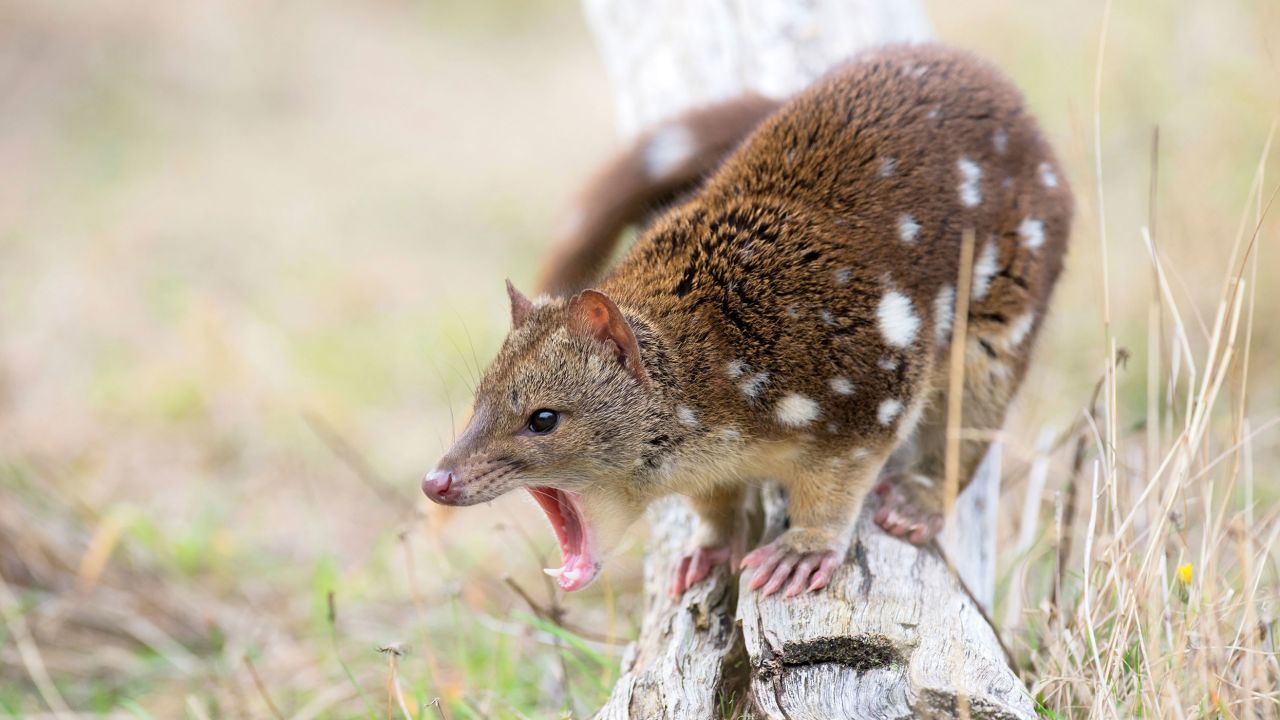Male northern quolls are so crazy about sex that scientists believe they die of exhaustion.
(Credit: David Sewell/Alamy)
(CNN) --
Most people learn about "the birds and the bees" when they're young, but sex in the animal kingdom isn't for the faint of heart.
For every peacock that unfurls its dazzling feathers to attract a peacock, there is another creature that does something strange, or even deadly, in the name of passing on its genes.
This Valentine's Day, meet the animals with more complicated love lives than yours.
Marsupials in love on a desperate mission
Related to the Tasmanian devil, the northern quoll is a small carnivorous marsupial that is the subject of a biological mystery.
Males die after just one mating season, and no one knows why.
Now, the researchers have proposed an explanation in a recent scientific paper: Male quolls are so crazy about sex that they die of exhaustion.
advertising
The quoll is not the only one that dies after a mating season: it is a reproductive strategy called semelparity, present in animals such as salmon and praying mantises.
Joshua Gaschk, a PhD fellow at the University of the Sunshine Coast in Australia, and his colleagues equipped wild quolls in northern Australia with trackers to study how they move.
(Gaschk described the quoll as "a feisty animal that bites very hard.")
After the quolls were released, the researchers recaptured them to retrieve the tracking devices 42 days later, a period that coincided with the quolls' mating season.
The team of researchers observed something surprising: the male quolls moved much more than the females and only rested 7% of the time, compared to 24% of the females.
Shocking fossils of spiders, insects and fish tell the story of Australia's origins
"Essentially, they try to cover great distances to find more mates, and they do so at the cost of their recovery and rest period," says Gaschk, lead author of the study published in the Royal Society Open Science journal.
Driven by sexual frenzy, this behavior could be the answer to why male quolls die after one mating season, while females survive for up to four, according to the researchers.
The tracker data seems to explain the death of male quolls, but theories differ as to why an animal evolves towards semelparity.
Some scientists say this frees up resources, while others suggest that the death of one or both sexes after a mating season helps ensure they "have it all" when it comes to passing on their genes.
Male anglerfish are the best graspers
To survive without the sunniest and shallowest water resources, the creatures of the deep have evolved to become, to paraphrase Charles Darwin, endless forms of the strangest.
Take anglerfish, for example: you might remember it from "Finding Nemo," with its bioluminescent lure and gnashing teeth.
What you may not know is that that villainous fish was female.
A small male anglerfish clings to the belly of a larger female.
Once the male locates the female, he clings to her with her pincer-like teeth.
(Credit: Rebikoff Foundation)
In deep-sea anglerfish, the male is nothing more than "a little sperm-filled sac that responds hormonally to the female's mature ovaries," explains Ted Pietsch, professor emeritus in the University of California's School of Aquatic and Fisheries Sciences. Washington.
"Females hunt and feed. Males, their only purpose in life is to find a female."
The male, which in some species is only one sixtieth the length of the female, has eyes and nostrils too large to find a mate.
Once the male locates the female, he clings to her with her pincer-like teeth.
Sometimes a male anglerfish only lasts long enough to release his sperm to fertilize the female's eggs.
In other cases, the male stays.
"The longer it stays attached, the more chance there is that the tissues of the male and female will fuse together," Pietsch explains.
"Real cells melt together, it's like being welded together."
Sometimes they even share a bloodstream, which helps maintain the male.
According to Pietsch, anglerfish may have developed this strange mating strategy to survive in the depths, where food is scarce.
For years, scientists only knew of these fish from the dead specimens they pulled up from the depths.
The Rebikoff-Niggeler Foundation of Portugal published in 2018 the first footage of a live anglerfish pair, drifting in the depths off the coast of the Azores, in the North Atlantic Ocean.
The diminutive male is attached to the female's belly, barely noticeable among her trailing illuminated tendrils.
Fire beetles gain mates with a toxic substance
You may be expecting chocolates this Valentine's Day.
Female fire beetles have another gift in mind: a poisonous substance on the head of a potential suitor.
Male
Neopyrochroa flabellata
beetles are attracted to a chemical called cantharidin.
"The males eat the substance as if it were candy," explains Dan Young, a professor of entomology at the University of Wisconsin Madison.
"Then they retain it in their body and transfer it to the females when they mate."
Attracted by the goo of cantharidin secreted by a suitor's glands, the female fire beetle accepts her male partner, whose sperm packet deposits more of the toxin during intercourse.
(Credit: Dan Young)
A male attracts a potential mate by secreting a cantharidin-containing substance from a gland on his head for females to taste.
"She approaches the male head-on and literally tastes the substance, and is basically asking the question: 'Can you come out? Do you have enough cantharidin to satisfy my desires?'
And if it doesn't, it doesn't mate with it," Young explains.
Once the goo is ingested, the female gives in to his advances and receives much more cantharidin in the male's sperm packet, which she can secrete to coat her eggs and make them unpalatable to predators.
(The toxin, also called the Spanish fly, has been used as an aphrodisiac, but it can also be deadly to humans in high concentrations.)
Although it is produced by blister beetles in other parts of the world, cantharidin does not appear to be available in nature where N. flabellata lives.
"I wonder if there's some other compound in nature that, from the beetle's point of view, looks like cantharidin, and they're being fooled," Young says.
As scientists try to solve the mystery of beetles' fondness for a substance they can't produce or find in nature (and the adaptations that seem right for it), check out this TikTok tune that dramatizes the bizarre mating behavior. from N. flabellata.
Snails switch mating roles and shoot 'love darts'
For countless species, sex is not a simple male-female binary: 30% of all animals are hermaphrodites in some way, if insects are excluded.
Joris Koene, Associate Professor of Ecology at the Vrije University of Amsterdam, studies the reproductive practices of land and freshwater snails, which he describes as "male and female at the same time," as each individual is capable of producing both eggs as sperm.
Same-sex penguin couple are parents for the first time at the New York Zoo
Producing large cells like eggs is resource intensive, but having each snail individually primed to take on either mating role provides a key benefit.
"As soon as it meets another adult individual, it's a potential mating partner," Koene says.
For snails, sex is not a simple male-female binary.
(Credit: Dr. Joris M. Koene)
When a couple of snails meet, they both approach and get to work.
During mating, the sperm-providing snail pulls its penis out of an opening in its head called the genital pore and inserts it into its partner's genital pore to transfer sperm.
Some of the transferred sperm fertilizes the egg, but the rest is diverted into the digestive tract of the recipient snail.
To help get more of that sperm used for fertilization rather than food, the sperm donor snail has another trick up its sleeve.
Love darts are tiny spikes made of the same calcium crystals as snail shells.
During the mating of some species, the sperm-bearing snail shoots its mate with these darts.
The darts are coated with a mucus containing proteins that act on the musculature of the recipient snail's reproductive tract, causing more of the sperm to stay in place instead of traveling to the digestive system.
And here's an interesting twist on the Cupid's arrow myth: "The amount of sperm that is stored (for fertilization) depends on the quality of the individual's aim," Koene explains.
Female lizards breed alone.
Sexual reproduction provides genetic diversity that can lead to a healthier overall population, but can be difficult to achieve, especially when mates are few.
When sex is not an option, some animals resort to an unusual method of asexual reproduction.
In parthenogenesis, or "virgin birth," a female is capable of fertilizing her own eggs with a recombination of her own DNA.
For some creatures, such as zebra sharks, it may be a "last resort" when a mate is not available.
Two female Gila lizards bask in the sun.
This is one of many species of female lizards that reproduce by cloning or parthenogenesis.
(Credit: Wild Horizons/Universal Images Group/Getty Images)
But a handful of animals, including several species of whiptail lizards, have evolved in such a way that there are no males at all, and parthenogenesis is the only reproduction possible.
"There are some species that reproduce asexually, but the males still play some role, whether it's causing ovulation or fertilization, but in these lizards they don't need the males at all," explains Sonal Singhal, associate professor of biology at California State University at Dominguez Hills.
These spiders can eat snakes up to 30 times their size.
These whiptail species are 100% female.
However, the lack of sexual reproduction does not mean that they do not have sexual behaviors.
Scientists have observed that some species engage in "pseudosexual" activities, such as mating between females, which can help promote ovulation.
If you want to know more about the behavior of females in the wild, check out the article "How Zoology Got Female Animals Wrong."
How zoology got the female animals wrong
Kate Golembiewski is a Chicago-based freelance science writer with a passion for zoology, thermodynamics, and death. She hosts the comedy show "A Scientist Walks Into a Bar."
AnimalsValentine














